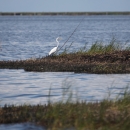Overview
The Dover Chemical Site (the “Site”) occupies approximately 60 acres on the east bank of Sugar Creek, approximately 1 mile above the confluence with the Tuscarawas River in east central Ohio. The Dover Chemical Corporation facility has been in production since 1949, producing chlorinated organic compounds, including dichlorobenzene, trichlorobenzene, tetrachlorobisphenol A (TCBA), and dihydroxybenzophenone by-products (later replaced with chlorinated paraffin by-products). Decades of spills and improper disposal activities have resulted in severe contamination of Site soils, ground water and surface waters of Sugar Creek (including floodplain soils and sediments).
Trustees
The trustees for natural resources are the U.S. Department of the Interior, acting through the Fish and Wildlife Service and the State of Ohio, acting through the Ohio Environmental Protection Agency (OEPA) (the “Trustees”). The Trustees initiated a natural resource damage assessment (NRDAR) in 2009 under the Comprehensive Environmental Response, Compensation and Liability Act (CERCLA).
Assessment
Pursuant to the applicable regulations, the Trustees invited the potentially responsible party to join a cooperative assessment, but it declined. The Trustees proceeded to finalize and implement an Assessment Plan in 2010 (See 43 C.F.R. §§ 11.30-11.38) to determine the extent of injuries from the release of hazardous substances. The Trustees concluded that fish and wildlife in Sugar Creek and surrounding habitat have been exposed to hazardous substances, including but not necessarily limited to, polychlorinated dibenzodioxins, polychlorinated dibenzofurans, hexachlorobenzene, and various chlorinated benzenes.
Settlement
The Trustees entered into settlement negotiations with Dover Chemical Corporation to address natural resource injuries, and on February 27, 2023, a Motion to Enter a proposed Consent Decree was entered with the court. The proposed Consent Decree specifies that Dover Chemical Corporation will fund and implement four restoration-based ecological projects valued at $1,045,000 and provide the State of Ohio with $880,000 to fund future groundwater restoration projects.
Restoration
Together, the Trustees prepared a Draft Restoration Plan and Environmental Assessment for the Sugar Creek Valley Natural Resource Damage Assessment at the Dover Chemical Corporation Site (draft RP/EA) that describes proposed restoration actions in the negotiated settlement. The draft RP/EA was made available for public review and comment from October 3, 2022 until November 2, 2022. After the public review and comment period, the Trustees reviewed and responded to the public comments received and prepared the Final Restoration Plan and Environmental Assessment for the Sugar Creek Valley Natural Resource Damage Assessment at the Dover Chemical Corporation Site (final RP/EA), which was noticed on February 27, 2023.
Administrative Record Index
The U.S. Fish and Wildlife Service is in the process of updating webpages, so some content that was previously available is temporarily unavailable. Please contact Deborah Millsap for additional information.




